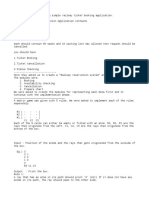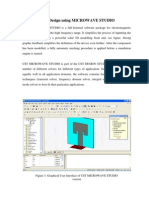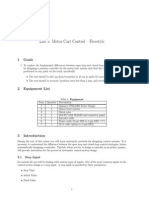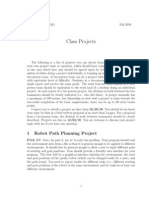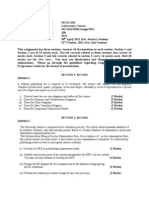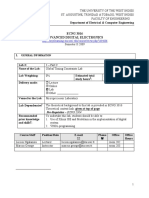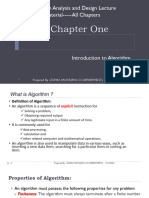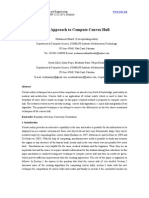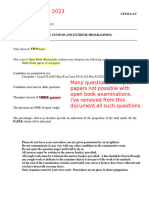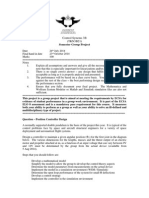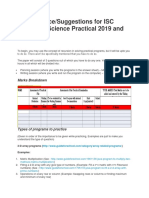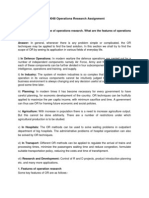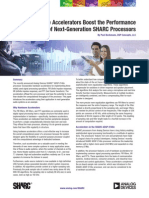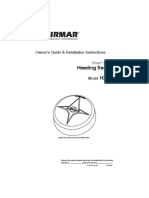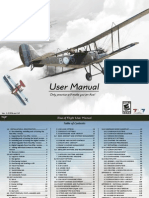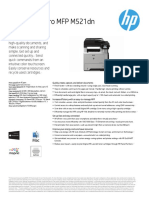Exam - 2007 03 26
Exam - 2007 03 26
Uploaded by
Martin Quang NguyenCopyright:
Available Formats
Exam - 2007 03 26
Exam - 2007 03 26
Uploaded by
Martin Quang NguyenOriginal Description:
Original Title
Copyright
Available Formats
Share this document
Did you find this document useful?
Is this content inappropriate?
Copyright:
Available Formats
Exam - 2007 03 26
Exam - 2007 03 26
Uploaded by
Martin Quang NguyenCopyright:
Available Formats
Examination CD5360 Software Engineering course (Examination 4 course points) Date: 2007-03-26, 8:30- 13:30 Contact person: Rikard
Land, 021-107035, 0735-636260 Responsible: Rikard Land Yue Lu Kristian Sandstrm Aneta Vulgarakis
All written material is allowed, e.g. text books, printouts of lecture slides, earlier exams (and solutions), and all own notes Max points: 40 Approved: Minimum 20 points Final Course Marks will be combined from the examination and the project: (40 points from examination + 40 points from the project) /2 Grade 5: 34 40p Grade 4: 28 33p Grade 3: 20 27p Observe, please: Write your name and personal number on every sheet Write on one side of the sheet only. Assumptions must be made when there is not enough information provided to solve an assignment, and all assumptions must be specified and explained in order to achieve full point.
Page 1(6)
Examination CD5360 Software Engineering course (Examination 4 course points) Date: 2007-03-26, 8:30- 13:30
Assignment 1. Requirements/Use Case modelling (6p)
In this assignment, you should model an aircraft boarding system by using UML UseCase diagram. The following are the requirements on the system. 45 minutes before take-off, one channel is opened in the boarding gate for the business / 1st class passengers. These passengers are informed by broadcasting by both airport TV and radio 30 minutes before take-off, an economy class channel is opened. and notify the boarding message to the economy class passengers by using both airport TV and radio. Meanwhile, keep the business / 1st class channel open If all of the business / 1st class passengers, who have already checked in their luggage, finish the boarding, that channel should be opened for the economy class passengers as well The passengers tickets and passports should be controlled, both in 1st / business class channel and economy class channel. If there is something wrong, the problem should be solved without stopping boarding for the other passengers The number of passengers should never exceed the capacity of aircraft It is allowed to disembarking during the boarding Before the gate is closed and the aircraft takes off, passengers who have already checked in the luggage but not shown up at the boarding gate 15 minutes before take-off should be called for by broadcasting by both airport TV and radio The boarding gate should be closed 10 minutes before take-off. There are no set numbers; passengers are allowed aboard on a first-come-firstserved basis.
Your task is to create a use case diagram with at least two actors (passenger, airways staff) and six scenarios. Please note that many use cases are probably not supported by a computerized system, you just need to describe who does what. No text description is needed, only a use case diagram (with descriptive names of the use cases).
Page 2(6)
Examination CD5360 Software Engineering course (Examination 4 course points) Date: 2007-03-26, 8:30- 13:30
Assignment 2. Project Management (10p)
You work in a project that will develop software for a series of washing machines. You have, together with your customer (the dishwasher manufacturer) defined the overall system requirements. You have agreed what buttons and displays there will be on the front of the washing machine, and you have defined a hardware abstraction layer is also defined to ensure portability to new hardware in the future (only one layer will need to be modified if the hardware is replaced). See the figure. There are three people (including yourself) working full-time in the project. Everyone can do any task in the project. Up to today (March 26th) you and your team have spent four weeks on agreeing on the system requirements with the customer, and you have estimated the development time for each part as follows is described in the notes in the figure.
User Interface Internal design: 8 manweeks Implementation: 8 manweeks Test & Verification: 8 manweeks
Control System
Internal design: 8 manweeks Implementation: 8 manweeks Test & Verification: 8 manweeks
Hardware Abstraction Layer
Internal design: 8 manweeks Implementation: 8 manweeks Test & Verification: 8 manweeks
You now have the option of selecting a development model for the rest of the project. For each of the following development models, define milestones and deliverables (with dates). Also describe briefly how each development model influence project risks and affects the ways you can collaborate with the customer. a) iterative (5p) b) incremental (5p) (Please note that no Gantt chart or resource allocation diagram is required, only lists of milestones and deliverables, plus discussions of risks and customer contact.) Hint for full points: also assume reasonable time estimates for other tasks not listed!
Page 3(6)
Examination CD5360 Software Engineering course (Examination 4 course points) Date: 2007-03-26, 8:30- 13:30
Assignment 3. Statechart Modelling & Safety Analysis (8p)
In this assignment, you will model the behavior of the control system that lowers and raises the gate where a road crosses a railway.
CT
CT
Road
Far
Near
Near
Far
Train Passed
Train Passed
There are two sensors, e.g. Sensor One (left) and Sensor Two (right) respectively, telling the gate that a train is passed. This is a classical example of a real-time system, which we will only model very coarsely here, assuming that there is only a single track with only one train at a time and one gate in this assignment. However, a train could go in either direction. There are some specifications of the scenario following. When a sensor detects that a train passes, it will emit the signal Train Passed to the gate controller system, in order to make the gate start moving to the opposite direction to the previous one, e.g. from state up to state down We assume that the gate needs between 20 and 30 seconds to be lowered (to go from the state up to the state down) or be raised (to go from the state down to the state up) or to come down The gate cannot be moved when the train is passing. Otherwise, it will lead to tragedy Your task is to: a) model the system behavior by using UML State chart diagram. (4p) b) construct a fault-tree and use it to point out weaknesses of the system, and describe how the system could be improved to be more safe. (4p)
Page 4(6)
Examination CD5360 Software Engineering course (Examination 4 course points) Date: 2007-03-26, 8:30- 13:30
Assignment 4. Testing (8p)
You are given a program that accepts 3 numbers as input (length of sides of triangle). The program output is taken from the set {Equilateral, Isosceles, Scalene, Invalid}. The program is supposed to choose the most specific descriptor. (i.e 2,2,2 should return Equilateral and 2,2,1 should return Isosceles.) You do not have the source code for this program. a) Is this a white box or black box testing? Explain. (2p) b) Name at least two advantages and two disadvantages of each approach. (4p) c) Why are both approaches necessary? (2p)
Page 5(6)
Examination CD5360 Software Engineering course (Examination 4 course points) Date: 2007-03-26, 8:30- 13:30
Assignment 5. Real-Time System Design (8p)
Most real-time systems control physical systems by observing (sampling) the system, calculating an appropriate response and output that response to the system (actuate). The resulting control performance will partly depend on the precision of the timing of sampling and actuation. Hence, timing is an important property is these systems. Consider the following questions regarding timing in real-time systems. a) Why it is necessary to consider timing variations in sampling and actuation respectively? Specify details about why and how control performance is affected by timing variations in sampling and actuation respectively. (4p) b) What in a computer system can cause these variations? Give three examples. (2p) c) What can be done to deal with variations in sampling and actuation? Do not repeat the answer to question b), but give details about how to actually make improvements. (2p)
Page 6(6)
You might also like
- Zoho Round 3 Question SetDocument20 pagesZoho Round 3 Question SetFree Fire Tamil88% (16)
- Stochastic Processes - RossDocument520 pagesStochastic Processes - Rossmarcogarieri88% (8)
- Traktor Signatures Set-Up DubfireDocument1 pageTraktor Signatures Set-Up DubfireAndres Fernando Rodriguez JaramilloNo ratings yet
- Patch Antenna Design Using MICROWAVE STUDIODocument5 pagesPatch Antenna Design Using MICROWAVE STUDIOnehajnitNo ratings yet
- CompTIA IT FundamentalsDocument295 pagesCompTIA IT Fundamentalsthphuongster94% (18)
- How To Compile Avl On Windows Using MinGW Without X 11 LibraryDocument2 pagesHow To Compile Avl On Windows Using MinGW Without X 11 LibraryPaul Pipi OkonkwoNo ratings yet
- Lab 3: Motor Cart Control - Freestyle: 1 GoalsDocument6 pagesLab 3: Motor Cart Control - Freestyle: 1 GoalsAnudeepReddyNo ratings yet
- Operating Systems Assignment: Department of Computer Science & EngineeringDocument4 pagesOperating Systems Assignment: Department of Computer Science & EngineeringSankalp JainNo ratings yet
- Lab Project: Shift-and-Add Multiplication Circuit With StorageDocument5 pagesLab Project: Shift-and-Add Multiplication Circuit With StoragesneophNo ratings yet
- AssinmentDocument2 pagesAssinmentAbubakr Alisawy100% (1)
- Beng Elec Spec 2013Document18 pagesBeng Elec Spec 2013Faraz AhmadNo ratings yet
- List of Projects 091109Document2 pagesList of Projects 091109Sharif Mohammad AdwanNo ratings yet
- ML 1 ProjectDocument2 pagesML 1 ProjectChaitanya SangaNo ratings yet
- 10 Tips For Successful Scan Design Part OneDocument6 pages10 Tips For Successful Scan Design Part Onebesha1987No ratings yet
- Analog SimulationDocument9 pagesAnalog SimulationMotaz Ahmad AmeenNo ratings yet
- Assignment 2 PDFDocument6 pagesAssignment 2 PDFsunnyopgNo ratings yet
- ProjectDocument4 pagesProjectlinsengao9No ratings yet
- Computer Science 37 HW 2Document5 pagesComputer Science 37 HW 2Alexander TaylorNo ratings yet
- CS224 - Spring 2021 - Lab #5 Implementing The MIPS Processor With Pipelined MicroarchitectureDocument5 pagesCS224 - Spring 2021 - Lab #5 Implementing The MIPS Processor With Pipelined MicroarchitectureArda Barış ÖrtlekNo ratings yet
- Assign 2Document4 pagesAssign 2Snow NguyễnNo ratings yet
- 0-ICPC Nov042023Document11 pages0-ICPC Nov042023zs3783999No ratings yet
- Projects 2010Document5 pagesProjects 2010Bhanu Teerth SamaNo ratings yet
- Optimal Path Generation of A Axis Robot For Auto Industrial PDFDocument6 pagesOptimal Path Generation of A Axis Robot For Auto Industrial PDFtintucinbNo ratings yet
- MCSL 36Document2 pagesMCSL 36Anusha SinhaNo ratings yet
- Assignment 1Document4 pagesAssignment 1Ashutosh SinghNo ratings yet
- LAB No.3 - CN 428 - Spring 2022Document3 pagesLAB No.3 - CN 428 - Spring 2022NURSELI KURTNo ratings yet
- ECNG 3016 Advanced Digital Electronics: Eneral NformationDocument25 pagesECNG 3016 Advanced Digital Electronics: Eneral NformationMarlon BoucaudNo ratings yet
- Computer Science and Applications: Test Booklet NoDocument40 pagesComputer Science and Applications: Test Booklet NoDr-Anindya HalderNo ratings yet
- ECNG3016 Practical 4Document7 pagesECNG3016 Practical 4Marlon BoucaudNo ratings yet
- Simulation MismatchDocument7 pagesSimulation Mismatchavinashnani1164No ratings yet
- EP100 Mock Exam June 2008Document5 pagesEP100 Mock Exam June 2008Valentino de GeorgeNo ratings yet
- Algorithm Analysis All ChaptersDocument150 pagesAlgorithm Analysis All Chapterslidib47128No ratings yet
- Project ReportDocument9 pagesProject Reportsmm azadNo ratings yet
- DAA Complete Notes 2Document240 pagesDAA Complete Notes 2anushkamishra545No ratings yet
- Huong Dan ARQDocument10 pagesHuong Dan ARQThanh TrầnNo ratings yet
- Hardw S97Document10 pagesHardw S97Dinesh DevaracondaNo ratings yet
- Wear Testing RigDocument6 pagesWear Testing Rigibson045001256No ratings yet
- System Dynamics and Control Itü ProgramDocument3 pagesSystem Dynamics and Control Itü ProgramCeren ArpakNo ratings yet
- DAA Module-1Document96 pagesDAA Module-1Zeha 1No ratings yet
- 20 Convex Hull Last 7Document8 pages20 Convex Hull Last 7iisteNo ratings yet
- Previous Exams 2022-23 AnnotatedDocument62 pagesPrevious Exams 2022-23 AnnotateddynxqcrygNo ratings yet
- DAA Unit-1Document48 pagesDAA Unit-1pihadar269No ratings yet
- CSC 369H1 F Operating Systems University of Toronto FALL 2003 Midterm Test No Aids AllowedDocument7 pagesCSC 369H1 F Operating Systems University of Toronto FALL 2003 Midterm Test No Aids AllowedLolo LalaNo ratings yet
- Standardized Work and Problem SolvingDocument34 pagesStandardized Work and Problem Solvingjayeshjpillai100% (4)
- System IdentificationDocument68 pagesSystem Identificationdaniel floresNo ratings yet
- CFD Basics & Use of ANSY FLUENT in Engineering Application: A BriefDocument49 pagesCFD Basics & Use of ANSY FLUENT in Engineering Application: A BrieftonysawanNo ratings yet
- Practice Exam Computer ArchitectureDocument15 pagesPractice Exam Computer ArchitectureMuhammad UsmanNo ratings yet
- I. General Simulation Concept: (68%, Problems 1-7: 3 Points Each, Problem 8: 2 Points Each)Document3 pagesI. General Simulation Concept: (68%, Problems 1-7: 3 Points Each, Problem 8: 2 Points Each)Sharif M Mizanur RahmanNo ratings yet
- UJ Control SemesterProject July2014Document6 pagesUJ Control SemesterProject July2014khwezitoniNo ratings yet
- Morning VersionDocument6 pagesMorning Version100510057No ratings yet
- Basis Path Testing PaperDocument22 pagesBasis Path Testing PaperAreej Al MajedNo ratings yet
- (Notes) DESIGN FOR TESTABILITYDocument34 pages(Notes) DESIGN FOR TESTABILITYsarathkumarNo ratings yet
- 01Document5 pages01Ram AnandNo ratings yet
- Picket Fence and Photo GateDocument2 pagesPicket Fence and Photo GatewalyatNo ratings yet
- Isc Practical Advice-2019onwardsDocument19 pagesIsc Practical Advice-2019onwardspraveenakjk13No ratings yet
- HNVN TR 07016 UnitTestingwithNUnit Assignment2Document2 pagesHNVN TR 07016 UnitTestingwithNUnit Assignment2NguyễnTinNo ratings yet
- MB0048 Operations ResearchDocument8 pagesMB0048 Operations Researchpkm7929No ratings yet
- Computer Networks Lab Syllabus III Year B.Tech. CSE - I SemDocument87 pagesComputer Networks Lab Syllabus III Year B.Tech. CSE - I SemAnonymous JwoypMYNo ratings yet
- Lock Up Latch in VLSIDocument8 pagesLock Up Latch in VLSIsandy_711100% (1)
- Software Testing and Quality Assurance: ETCS - 453Document53 pagesSoftware Testing and Quality Assurance: ETCS - 453madhavNo ratings yet
- HP-ADS Tutorial 2015Document32 pagesHP-ADS Tutorial 2015Ahmad UsmanNo ratings yet
- COMSATS University Islamabad Sahiwal Campus: (Computer Science)Document2 pagesCOMSATS University Islamabad Sahiwal Campus: (Computer Science)Muhammad HussainNo ratings yet
- NGTS PHD ThesisDocument177 pagesNGTS PHD ThesisMartin Quang NguyenNo ratings yet
- ISYE 3039 Methods For Quality Improvement Spring 2013 in Class Quiz 1 Solution Jan 29 2013Document1 pageISYE 3039 Methods For Quality Improvement Spring 2013 in Class Quiz 1 Solution Jan 29 2013Martin Quang NguyenNo ratings yet
- Junior TalkDocument83 pagesJunior TalkMartin Quang NguyenNo ratings yet
- Pascal ReferenceDocument290 pagesPascal ReferenceMartin Quang NguyenNo ratings yet
- 1296 MHZ Moon BeaconDocument9 pages1296 MHZ Moon Beaconmiguel.pelicano@gmail.comNo ratings yet
- 1 XxvayfefDocument3 pages1 XxvayfefRavi Kiran ReddyNo ratings yet
- CS Fredrick NyirendaDocument31 pagesCS Fredrick NyirendafrednyirendajataNo ratings yet
- Karthik KDocument3 pagesKarthik KKarthik KNo ratings yet
- SHARC Hardware AcceleratorsDocument2 pagesSHARC Hardware Acceleratorsjcxz6053No ratings yet
- Heading Sensor: Owner's Guide & Installation InstructionsDocument16 pagesHeading Sensor: Owner's Guide & Installation InstructionsRANDOMNo ratings yet
- Simotion SCOUT CamTool - ProgrammingDocument114 pagesSimotion SCOUT CamTool - ProgrammingBobWhalerNo ratings yet
- Storage Basics: DAS, SAN, and NAS Storage SubsystemsDocument12 pagesStorage Basics: DAS, SAN, and NAS Storage Subsystemssurajit_choudhuryNo ratings yet
- Opposed Piston Engine - 1 - Mechanical Seminar TopicsDocument4 pagesOpposed Piston Engine - 1 - Mechanical Seminar Topicssumitsinha89No ratings yet
- Adapter List 2011Q4 ADocument11 pagesAdapter List 2011Q4 ATint Zaw OoNo ratings yet
- DVJX 1Document136 pagesDVJX 1Silvinho JúniorNo ratings yet
- 13.8v Power Supply PS HighCurrentDocument17 pages13.8v Power Supply PS HighCurrentMadumathi BulumullaNo ratings yet
- T1600G-28TS V1 Ug PDFDocument269 pagesT1600G-28TS V1 Ug PDFSebiNo ratings yet
- ROF Manual English 130b Rev1Document156 pagesROF Manual English 130b Rev1GambolputtyNo ratings yet
- Chandana Haldar BhuDocument11 pagesChandana Haldar BhutsrforfunNo ratings yet
- Hard Drive Failure DiagnosticsDocument15 pagesHard Drive Failure DiagnosticsSocorro FloresNo ratings yet
- O-Ring Seal Sizes: From Micro To Macro, We Have Every Size You NeedDocument36 pagesO-Ring Seal Sizes: From Micro To Macro, We Have Every Size You NeedMorteza ShakerienNo ratings yet
- Samsung Ue40f6320a Ue46f6320aw Ue55f6320aw Chassis U85aDocument105 pagesSamsung Ue40f6320a Ue46f6320aw Ue55f6320aw Chassis U85aIdrishka Babouchka100% (1)
- Grade 11 SMAWDocument2 pagesGrade 11 SMAWMari An Darasin DaguinodNo ratings yet
- Stacks & SubroutinesDocument35 pagesStacks & SubroutinesAnshy SinghNo ratings yet
- Multisim Templates For Custom Arduino Shields - National InstrumentsDocument3 pagesMultisim Templates For Custom Arduino Shields - National Instrumentsefasaravanan0% (1)
- TRINITY GCSL S2707 Quick Reference: J22 Front Panel ConnectorDocument1 pageTRINITY GCSL S2707 Quick Reference: J22 Front Panel Connectorrick krossNo ratings yet
- HP Laserjet Pro MFP M521Dn: DatasheetDocument2 pagesHP Laserjet Pro MFP M521Dn: Datasheetoscar Daniel Grajeda cortesNo ratings yet
- ADE7763Document57 pagesADE7763mailabautroixanh39No ratings yet
- Telecommunications Intermediateb2Document10 pagesTelecommunications Intermediateb2Javad SamadiNo ratings yet
- Tm1 Messageloganalysis enDocument8 pagesTm1 Messageloganalysis en'SudarshanRaiNo ratings yet
- Analog Computers: The Analog Computer Is Almost An Extinct Type of Computer TheseDocument4 pagesAnalog Computers: The Analog Computer Is Almost An Extinct Type of Computer TheseKundaiNo ratings yet
